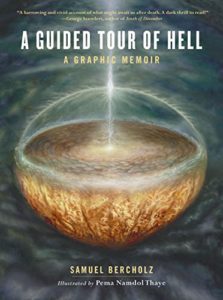Near-Death Experiencer Sam Bercholz

Sam Bercholz is a senior teacher in the Kagyu and Nyingma lineages of Tibetan Buddhism and has been teaching Buddhist meditation and philosophy for over forty years. He holds the lineages of both Chögyam Trungpa Rinpoche and Thinley Norbu Rinpoche who both empowered him to teach dharma.
Sam’s recent book is about his near death experience and journey to a hellish bardo state. After a sextuple coronary bypass surgery, Mr. Bercholz experienced a vision of the underworld, a place of unending suffering where human souls go to meet their karmic retribution. Mr. Bercholz relayed his story to the renowned Tibetan artist Pema Namdol Thaye. Part Dante’s Inferno, part Tibetan Book of the Dead, part Hellboy, the images graphically transport the reader and viewer into the horrifying world Bercholz describes. These paintings are complex, unforgettable, and truly unique, and several prestigious art institutions have already signed for special exhibitions of this work.
……………
Chapter 74 – The Beings Of Hell: Common Characteristics
Chapter 79 – Hell &The Importance Of Kindness
The quotes from both of these chapters appear in Sam’s book, A Guided Tour of Hell: A Graphic Memoir.
See below for additional quotes.
……………
Links:
• Shambhala Mountain Center
• Hellish & Distressing Near-Death Experiences
……………
Book:
A Guided Tour of Hell: A Graphic Memoir
By Samuel Bercholz (Author), Pema Namdol Thaye (Illustrator)
Take a trip through the realms of hell with a man whose temporary visitor’s pass gave him a horrifying — and enlightening — preview of its torments. This true account of Sam Bercholz’s near-death experience has more in common with Dante’s Inferno than it does with any of the popular feel-good stories of what happens when we die. In the aftermath of heart surgery, Sam, a longtime Buddhist practitioner and teacher, is surprised to find himself in the lowest realms of karmic rebirth, where he is sent to gain insight into human suffering. Under the guidance of a luminous being, Sam’s encounters with a series of hell-beings trapped in repetitious rounds of misery and delusion reveal to him how an individual’s own habits of fiery hatred and icy disdain, of grasping desire and nihilistic ennui, are the source of horrific agonies that pound consciousness for seemingly endless cycles of time. Comforted by the compassion of a winged goddess and sustained by the kindness of his Buddhist teachers, Sam eventually emerges from his ordeal with renewed faith that even the worst hell contains the seed of wakefulness. His story is offered, along with the modernist illustrations of a master of Tibetan sacred arts, in order to share what can be learned about awakening from our own self-created hells and helping others to find relief and liberation from theirs.
……………
Excerpts from A Guided Tour of Hell: A Graphic Memoir:
“The sufferings of each and every one of these beings are due to their own mental conceptions. In fact, their suffering in hell is an unbroken continuation of their own states of mind during life, which persisted even after the death of the physical body.
“Beings enter hell as a result of the sum total of their own life at the time of death. Whatever they brought to their lifetime — including all actions, thoughts, belief systems, desires, and habits of clarity or obscuration — all continues beyond the passing of the physical body.”
…
“My experience showed me that there are characteristics common to all the beings of hell: they possess a thoroughgoing materialism, combined with nihilism to varying degrees, and attitudes of hatred, disdain, and utter lack of concern or caring for other beings.”
…
“With a sensation like the sudden flash of a whip, the veil separating life from death was ripped away, and my consciousness was pulled violently into the realm beyond life. Translucent bindings, like strings of light, first lassoed my legs, then seized my whole being, and I was slammed forward. I felt myself hurled down and down. There was no “me,” just a center of consciousness descending farther and farther… falling into untold depths.
“I was dead.
“I had no eyes to see. I had no ears to hear, no nose to smell, no tongue to taste, no skin to feel… no voice to speak. All I had was a memory of those senses and those sense perceptions.
“Yet, though I had no eyes, a world appeared before me. My consciousness expanded from the tiny strings of light and into a complete cosmos made of sulfurous gases. Here was an alternative world, thoroughly different from the earthly world I had left behind. My senses were overwhelmed by the unbearable odor of burning flesh and extremes of heat and cold beyond imagination.
“Amid these intense sensations, a second display arose in shimmering waves of agonizing pain— the images of contorted faces, writhing bodies and ghastly body parts, festering entrails, disembodied thumbs and noses, tormented animals of every kind, some of them ripped into pieces, and even ants and other insects whose extreme suffering was palpable to me. All of them — all of it — was a mass of unspeakable pain. With the constant mirage-like wavering of images, I could not discern anything as either real or unreal.
“Space had no ordinary dimensionality, no up or down, no right or left. Only the habit of direction was there to produce the continuous sense of falling, but without any place to fall.
“From within the chaotic shimmering emerged a being of sublime light. Was it male or female? I could not say. A wordless message was somehow conveyed to me: This is the domain of hell. You have been brought here as a guest, to witness and understand the suffering of beings of all kinds — particularly the suffering of human beings.”
…
“The first-person glimpses of hell described in this book made an unforgettable impact like no other. It’s not that I perceived them as a scary warning to change my ways. Rather, the very ordinariness of hell was impressed on me — the recognition that the hellish inclinations of the ordinary mind are not reserved for exceptionally bad people. Above all, it was a lesson in the importance of kindness — a lesson almost too simple to seem significant, yet it holds the key to a happy life, and even to liberation itself…
“So the bad news is that hell exists — within our very minds. The good news is that even the worst hell contains the seed of freedom. Hell does not last forever…
“No hell is a totally forsaken experience, because within each kind of hell there is a Buddha — not a savior in the Western sense, but a manifestation of our innate wisdom — to awaken and guide us. In hell, a Buddha may appear as a subtle or formless presence. The same presence emanates sometimes as a female figure and sometimes as a male figure. To rouse us from our hellish stupor, whatever forms are needed will appear — whether peaceful and soothing, or wild and wrathful…
“At the meeting point of the hot and cold hells there resides the beneficent being whom I call the Buddha of Hell. His body is gray, and he holds fire and water in his hand. The textures that emanate from the fiery display and the glimmering water depict the path to liberation from hell. He offers the fire and water as signs of awakening so that beings can get to exit hell. It’s not seeing the fire and water that is the key, but rather experiencing the textures of the hotness of the flame and the coolness of the water. One ‘reads’ the fire and water by feeling the textures that they emanate, and the awareness of these textures provides a path out.
“The Buddha of Hell first appeared in a genderless body of light to greet me when I arrived at the juxtaposition of the hot and cold hells. His presence comforted me in my initial state of embarrassment and confusion. He took me by the hand and guided me through the various hellscapes, opening my inner eye to the extreme suffering caused by hatred, prejudice, uncontrolled anger, avoidance, self-destruction, and disdain toward sacredness.
“Through the Buddha’s hand, I felt natural compassion and caring for all the hell-beings. He was not a god who had created the beings or meted out their suffering, so it wasn’t really possible for the Buddha to save them; rather he offered his wisdom so that they could rise from this worst of all places to the higher realms and even to complete liberation from the rounds of all the realms. The Buddha of Hell, through his uncontrived nature, continuously touched each part of hell and left a mark there. Sometimes it was the mark of the bright halo that emanated from his gray form, sometimes his footsteps or handprints, whose texture all the beings could feel. Symbols of water might appear in the hot hells, and symbols of flames in the cold hells; other symbols included a Wheel of Dharma or a rainbow. It was possible for any of the hell-beings to stumble upon these marks, which would have the effect of casting doubt on their erroneous belief that hell is forever. The realization that a way out of one’s suffering is possible is truly the saving grace of hell.
“Unfortunately, beings in hell suffer from extreme aggression and tend to overlook the textures and signs that might lead to liberation. Hell-beings always want to escape, because everything is so unbearable, but alas, their escape attempts lead to further intensification of hell’s sufferings. Lashing out just causes more pain, and being quiet and internalizing everything just causes freezing. All attempts are a complete conundrum.
“Hell-beings try every which way to destroy themselves, but to no avail. Committing suicide in hell is just as hopeless as ordinary suicide, or perhaps it is worse because in hell, the result that follows lasts for millions of hallucinated years…
“These are some of the haunting images that have remained with me and, as strange and uncanny as they were, have enriched my life in profound and mysterious ways.”


